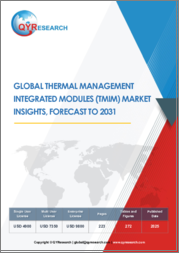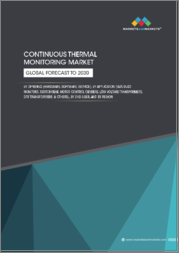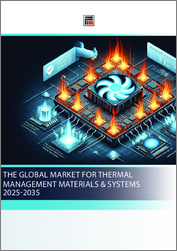
|
시장보고서
상품코드
1679211
열관리 시장 예측(-2030년) : 디바이스 유형, 재료, 냉각 기술, 최종사용자, 지역별 세계 분석Thermal Management Market Forecasts to 2030 - Global Analysis By Device Type (Active Thermal Management Devices and Passive Thermal Management Devices), Material, Cooling Technology, End User and By Geography |
||||||
Stratistics MRC에 따르면 세계의 열관리 시장은 2024년에 108억 9,000만 달러를 차지하며 2030년에는 CAGR 11.5%로 성장하며, 224억 3,000만 달러에 달할 것으로 예측됩니다.
열 관리는 시스템, 장비, 부품의 온도를 조절하여 최적의 성능, 효율성 및 수명을 보장하기 위해 사용되는 기술 및 프로세스를 의미합니다. 과도한 열이 고장이나 효율 저하를 유발하는 전자, 자동차, 항공우주, 산업 용도에서 매우 중요합니다. 효과적인 열 관리는 신뢰성을 높이고, 과열을 방지하고, 에너지 효율을 유지하기 위해 현대 엔지니어링 및 기술 설계의 중요한 측면이 되었습니다.
International Journal of Modeling and Optimization and Cooling India에 따르면 데이터센터 에너지 소비의 30-55%는 전력 냉각 및 환기 시스템에 사용됩니다.
소비자 전자제품 수요 증가
기기의 소형화 및 고성능화에 따라 발열량도 증가하여 성능 저하 및 하드웨어 고장을 방지하기 위한 효율적인 냉각 솔루션이 요구되고 있습니다. 히트파이프, 열 인터페이스 재료(TIM), 상변화물질와 같은 첨단 열 관리 기술은 디바이스의 효율성과 수명을 유지하는 데 도움이 됩니다. 제조업체들은 혁신적인 냉각 솔루션에 지속적으로 투자하여 시장 성장을 가속하고 최신 전자제품에서 최적의 열 성능을 보장하기 위해 노력하고 있습니다.
복잡한 설계 및 통합
전자, 자동차, 산업 시스템 등 다양한 용도에 맞는 맞춤형 솔루션이 필요하므로 열 관리는 복잡한 설계와 통합이 필요합니다. 다양한 열 부하, 공간 제약, 재료 호환성, 효율성 요구 사항 등의 문제로 인해 효과적인 냉각 시스템 설계가 어려워지고 있습니다. 이러한 복잡성은 개발 시간, 비용, 숙련된 전문 지식의 필요성을 증가시키고 채택을 제한하여 시장 성장을 저해합니다.
AI와 데이터센터의 발전
AI 기반 워크로드, 클라우드 컴퓨팅, 엣지 컴퓨팅은 엄청난 열을 발생시키기 때문에 과열을 방지하고 최적의 성능을 보장하는 효율적인 냉각 솔루션이 필요합니다. 고밀도 데이터센터에서는 에너지 효율 향상과 운영 비용 절감을 위해 수냉, 액침냉각, AI를 활용한 열 최적화 등 첨단 냉각 기술이 요구되고 있습니다. 전 세계 데이터 트래픽 증가와 하이퍼스케일 데이터센터의 확장에 따라 기업은 혁신적인 열 관리 솔루션에 투자하고 있습니다. 또한 지속가능성에 대한 관심은 친환경 냉각 방식을 촉진하고 시장 성장을 더욱 가속화하고 있습니다.
기술적 과제
전력 밀도 증가, 전자 부품의 소형화, 좁은 공간에서 고효율 냉각의 필요성으로 인해 열 관리는 기술적 문제에 직면해 있습니다. 첨단 냉각 솔루션의 개발은 대규모 연구개발이 필요하고 비용이 증가합니다. 이러한 기술을 성능 저하 없이 복잡한 시스템에 통합하는 것은 어렵습니다. 또한 재료의 한계와 지속가능하고 환경 친화적인 솔루션의 필요성은 개발을 더욱 복잡하게 만들고 시장 확대를 방해하고 있습니다.
COVID-19의 영향:
COVID-19는 공급망 지연, 원자재 부족, 제조 능력 저하로 인해 열관리 시장을 혼란에 빠뜨렸습니다. 초기에는 자동차 및 산업 부문의 둔화가 성장을 저해하는 요인으로 작용했으나, 팬데믹 이후 전기자동차와 5G 인프라의 급속한 보급이 시장 회복을 촉진했습니다. 전반적으로 이 위기는 열 관리 분야의 기술 혁신을 가속화하고 미래 설계에서 신뢰성, 에너지 효율성 및 지속가능성을 강조했습니다.
예측 기간 중 세라믹 기반 솔루션 부문이 가장 클 것으로 예상됩니다.
예측 기간 중 세라믹 기반 솔루션 부문이 가장 큰 시장 점유율을 차지할 것으로 예상됩니다. 세라믹 기반 열 관리 솔루션은 우수한 내열성, 높은 열전도율, 전기 절연성을 가지고 있으며, 전자, 자동차, 항공우주 산업 등의 용도에 적합합니다. 고성능, 경량, 지속가능한 열 관리 솔루션에 대한 수요가 증가함에 따라 채택이 확대되고 있습니다.
예측 기간 중 데이터센터 및 서버 분야가 가장 높은 CAGR을 나타낼 것으로 예상됩니다.
예측 기간 중 데이터센터 및 서버 분야가 가장 높은 성장률을 보일 것으로 예상됩니다. 데이터센터 및 서버의 열 관리는 최적의 성능을 유지하고 과열을 방지하며 에너지 효율성을 보장하기 위해 매우 중요하며, AI, 클라우드 컴퓨팅, 5G로 인한 데이터 처리 수요 증가에 따라 수랭식, 액침냉각, 고급 기류 관리와 같은 효과적인 냉각 솔루션이 필수적입니다. 솔루션이 필수적입니다.
가장 큰 점유율을 차지하는 지역
예측 기간 중 아시아태평양은 가전제품, 전기자동차(EV), 데이터센터의 확대로 인해 가장 큰 시장 점유율을 차지할 것으로 예상됩니다. 중국, 일본, 한국, 인도와 같은 국가들은 강력한 제조거점과 기술 발전으로 인해 주요 기업이 되었으며, 5G 네트워크, 산업 자동화, 스마트 기기의 부상으로 인해 수요가 더욱 증가할 것으로 예상됩니다. 전반적으로 아시아태평양은 열 관리 솔루션 시장으로서 지배적이며 경쟁이 치열합니다.
CAGR이 가장 높은 지역:
예측 기간 중 북미는 전기자동차(EV), 데이터센터, 항공우주, 소비자 전자제품의 발전으로 인해 가장 높은 CAGR을 나타낼 것으로 예상됩니다. 미국은 AI, 클라우드 컴퓨팅, 5G 인프라에 대한 대규모 투자로 인해 효율적인 냉각 솔루션에 대한 수요가 증가하면서 이 지역을 선도하고 있으며, EV 도입 증가와 엄격한 에너지 효율 규제가 시장 성장을 더욱 촉진하고 있습니다. 전반적으로 북미는 열 관리의 혁신과 채택에 있으며, 주요한 역할을 하고 있습니다.
무료 커스터마이징 서비스:
이 보고서를 구독하는 고객은 다음과 같은 무료 맞춤화 옵션 중 하나를 이용할 수 있습니다.
- 기업소개
- 추가 시장 기업의 종합 프로파일링(최대 3사)
- 주요 기업의 SWOT 분석(최대 3사)
- 지역 세분화
- 고객의 관심에 따른 주요 국가별 시장 추정, 예측, CAGR(주: 타당성 확인에 따라 다름)
- 경쟁사 벤치마킹
- 제품 포트폴리오, 지역적 입지, 전략적 제휴에 기반한 주요 기업의 벤치마킹
목차
제1장 개요
제2장 서문
- 개요
- 이해관계자
- 조사 범위
- 조사 방법
- 데이터 마이닝
- 데이터 분석
- 데이터 검증
- 조사 어프로치
- 조사 정보원
- 1차 조사 정보원
- 2차 조사 정보원
- 전제조건
제3장 시장 동향 분석
- 촉진요인
- 억제요인
- 기회
- 위협
- 기술 분석
- 최종사용자 분석
- 신흥 시장
- COVID-19의 영향
제4장 Porter's Five Forces 분석
- 공급 기업의 교섭력
- 바이어의 교섭력
- 대체품의 위협
- 신규 진출업체의 위협
- 경쟁 기업 간 경쟁 관계
제5장 세계의 열관리 시장 : 디바이스 유형별
- 액티브 열관리 디바이스
- 팬과 블로어
- 히트 싱크
- 열전 냉각기
- 액체 냉각 시스템
- 패시브 열관리 디바이스
- 히트 파이프
- 단열
- 증기 챔버
제6장 세계의 열관리 시장 : 재료별
- 열전달물질(TIM)
- 금속 기반 솔루션
- 세라믹 기반 솔루션
- 나노재료
- 기타 재료
제7장 세계의 열관리 시장 : 냉각 기술별
- 전도 냉각
- 대류 냉각
- 하이브리드 냉각 시스템
- 2상 냉각
- 기타 냉각 기술
제8장 세계의 열관리 시장 : 최종사용자별
- 자동차
- 가전
- 데이터센터와 서버
- 헬스케어
- 항공우주 및 방위
- 산업·제조업
- 에너지와 전력
- 기타 최종사용자
제9장 세계의 열관리 시장 : 지역별
- 북미
- 미국
- 캐나다
- 멕시코
- 유럽
- 독일
- 영국
- 이탈리아
- 프랑스
- 스페인
- 기타 유럽
- 아시아태평양
- 일본
- 중국
- 인도
- 호주
- 뉴질랜드
- 한국
- 기타 아시아태평양
- 남미
- 아르헨티나
- 브라질
- 칠레
- 기타 남미
- 중동 및 아프리카
- 사우디아라비아
- 아랍에미리트
- 카타르
- 남아프리카공화국
- 기타 중동 및 아프리카
제10장 주요 발전
- 계약, 파트너십, 협업, 합병사업
- 인수와 합병
- 신제품 발매
- 사업 확대
- 기타 주요 전략
제11장 기업 프로파일링
- Honeywell International Inc.
- Vertiv Holdings Co.
- Coherent Corporation
- Laird Thermal Systems
- Advanced Cooling Technologies, Inc.
- Delta Electronics, Inc.
- Henkel AG & Company, KGaA
- Parker Chomerics
- Prestone Limited
- Autoneum Holding AG
- European Thermodynamics Ltd.
- Aavid Thermalloy LLC
- Heatex AB
- Lord Corporation
- Dau Thermal Solutions Inc.
- Gentherm Inc.
- Thermacore Inc.
- Pentair Thermal Management
- Outlast Technologies LLC
- Clariant AG
According to Stratistics MRC, the Global Thermal Management Market is accounted for $10.89 billion in 2024 and is expected to reach $22.43 billion by 2030 growing at a CAGR of 11.5% during the forecast period. Thermal management refers to the techniques and processes used to regulate the temperature of systems, devices, or components to ensure optimal performance, efficiency, and longevity. It is crucial in electronics, automotive, aerospace, and industrial applications where excessive heat can cause failures or reduced efficiency. Effective thermal management enhances reliability, prevents overheating, and maintains energy efficiency, making it a critical aspect of modern engineering and technology design.
According to International Journal of Modeling and Optimization and Cooling India, 30-55% of a data center's energy consumption goes to power cooling and ventilation systems.
Market Dynamics:
Driver:
Rising demand for consumer electronics
As devices become more compact and powerful, they generate higher heat levels, requiring efficient cooling solutions to prevent performance degradation and hardware failures. Advanced thermal management technologies such as heat pipes, thermal interface materials (TIMs), and phase-change materials help maintain device efficiency and longevity. Manufacturers continuously invest in innovative cooling solutions, propelling market growth and ensuring optimal thermal performance in modern electronics.
Restraint:
Complex design and integration
Thermal management involves complex design and integration due to the need for customized solutions tailored to different applications, such as electronics, automotive, and industrial systems. Factors like varying heat loads, space constraints, material compatibility, and efficiency requirements make designing effective cooling systems challenging. This complexity increases development time, costs, and the need for skilled expertise, hampering market growth by limiting adoption.
Opportunity:
Advancements in AI and data centers
AI-driven workloads, cloud computing, and edge computing generate immense heat, requiring efficient cooling solutions to prevent overheating and ensure optimal performance. High-density data centers demand advanced cooling techniques like liquid cooling, immersion cooling, and AI-powered thermal optimization to enhance energy efficiency and reduce operational costs. With increasing global data traffic and the expansion of hyperscale data centers, companies invest in innovative thermal management solutions. Additionally, sustainability concerns push for eco-friendly cooling methods, further accelerating market growth.
Threat:
Technological challenges
Thermal management faces technological challenges due to increasing power densities, miniaturization of electronic components, and the need for high-efficiency cooling in compact spaces. Developing advanced cooling solutions, requires extensive R&D, driving up costs. Integrating these technologies into complex systems without compromising performance is difficult. Additionally, material limitations and the need for sustainable, eco-friendly solutions further complicate advancements and hampers the market expansion.
Covid-19 Impact:
The covid-19 pandemic disrupted the thermal management market by causing supply chain delays, raw material shortages, and reduced manufacturing capacity. The slowdown in automotive and industrial sectors initially hampered growth, but the rapid adoption of electric vehicles and 5G infrastructure post-pandemic fuelled market recovery. Overall, the crisis accelerated innovation in thermal management, emphasizing reliability, energy efficiency, and sustainability in future designs.
The ceramic-based solutions segment is expected to be the largest during the forecast period
The ceramic-based solutions segment is expected to account for the largest market share during the forecast period. Ceramic-based solutions in thermal management offer excellent heat resistance, high thermal conductivity, and electrical insulation, making them ideal for applications in electronics, automotive, and aerospace industries. Their adoption is growing due to rising demand for high-performance, lightweight, and sustainable thermal management solutions.
The data centers & servers segment is expected to have the highest CAGR during the forecast period
Over the forecast period, the data centers & servers segment is predicted to witness the highest growth rate. Thermal management in data centers and servers is crucial for maintaining optimal performance, preventing overheating, and ensuring energy efficiency. With increasing data processing demands from AI, cloud computing, and 5G, effective cooling solutions like liquid cooling, immersion cooling, and advanced airflow management are essential.
Region with largest share:
During the forecast period, the Asia Pacific region is expected to hold the largest market share driven by the expansion of consumer electronics, electric vehicles (EVs), and data centers. Countries like China, Japan, South Korea, and India are key players due to their strong manufacturing base and technological advancements. The rise of 5G networks, industrial automation, and smart devices further boosts demand. Overall, Asia-Pacific remains a dominant and highly competitive market for thermal management solutions.
Region with highest CAGR:
Over the forecast period, the North America region is anticipated to exhibit the highest CAGR fuelled by advancements in electric vehicles (EVs), data centers, aerospace, and consumer electronics. The U.S. leads the region with significant investments in AI, cloud computing, and 5G infrastructure, increasing demand for efficient cooling solutions. The rise in EV adoption and strict energy efficiency regulations further propel market growth. Overall, North America remains a key player in thermal management innovation and adoption.
Key players in the market
Some of the key players in Thermal Management market include Honeywell International Inc., Vertiv Holdings Co., Coherent Corporation, Laird Thermal Systems, Advanced Cooling Technologies, Inc., Delta Electronics, Inc., Henkel AG & Company, KGaA, Parker Chomerics, Prestone Limited, Autoneum Holding AG, European Thermodynamics Ltd., Aavid Thermalloy LLC, Heatex AB, Lord Corporation, Dau Thermal Solutions Inc., Gentherm Inc., Thermacore Inc., Pentair Thermal Management, Outlast Technologies LLC and Clariant AG.
Key Developments:
In January 2025, Coherent Corp. has introduced the CT-Series thermoelectric coolers, designed to provide high thermal performance and reliability for applications in life sciences, medical, and industrial sectors. Positioned between Coherent's XLT and RC product lines, the CT-Series offers a mid-tier solution that balances performance with targeted cycling capabilities.
In October 2024, Prestone introduced three advanced thermal management fluids tailored for electric vehicles (EVs), each designed to meet the stringent GB29743.2 standard, which mandates electrical conductivity below 100 µS/cm to enhance battery safety. These innovations underscore Prestone's commitment to advancing EV technology by addressing critical safety and performance challenges in thermal management.
Device Types Covered:
- Active Thermal Management Devices
- Passive Thermal Management Devices
Materials Covered:
- Thermal Interface Materials (TIMs)
- Metal-Based Solutions
- Ceramic-Based Solutions
- Nanomaterials
- Other Materials
Cooling Technologies Covered:
- Conduction Cooling
- Convection Cooling
- Hybrid Cooling Systems
- Two-Phase Cooling
- Other Cooling Technologies
End Users Covered:
- Automotives
- Consumer Electronics
- Data Centers & Servers
- Healthcare
- Aerospace & Defense
- Industrial & Manufacturing
- Energy & Power
- Other End Users
Regions Covered:
- North America
- US
- Canada
- Mexico
- Europe
- Germany
- UK
- Italy
- France
- Spain
- Rest of Europe
- Asia Pacific
- Japan
- China
- India
- Australia
- New Zealand
- South Korea
- Rest of Asia Pacific
- South America
- Argentina
- Brazil
- Chile
- Rest of South America
- Middle East & Africa
- Saudi Arabia
- UAE
- Qatar
- South Africa
- Rest of Middle East & Africa
What our report offers:
- Market share assessments for the regional and country-level segments
- Strategic recommendations for the new entrants
- Covers Market data for the years 2022, 2023, 2024, 2026, and 2030
- Market Trends (Drivers, Constraints, Opportunities, Threats, Challenges, Investment Opportunities, and recommendations)
- Strategic recommendations in key business segments based on the market estimations
- Competitive landscaping mapping the key common trends
- Company profiling with detailed strategies, financials, and recent developments
- Supply chain trends mapping the latest technological advancements
Free Customization Offerings:
All the customers of this report will be entitled to receive one of the following free customization options:
- Company Profiling
- Comprehensive profiling of additional market players (up to 3)
- SWOT Analysis of key players (up to 3)
- Regional Segmentation
- Market estimations, Forecasts and CAGR of any prominent country as per the client's interest (Note: Depends on feasibility check)
- Competitive Benchmarking
- Benchmarking of key players based on product portfolio, geographical presence, and strategic alliances
Table of Contents
1 Executive Summary
2 Preface
- 2.1 Abstract
- 2.2 Stake Holders
- 2.3 Research Scope
- 2.4 Research Methodology
- 2.4.1 Data Mining
- 2.4.2 Data Analysis
- 2.4.3 Data Validation
- 2.4.4 Research Approach
- 2.5 Research Sources
- 2.5.1 Primary Research Sources
- 2.5.2 Secondary Research Sources
- 2.5.3 Assumptions
3 Market Trend Analysis
- 3.1 Introduction
- 3.2 Drivers
- 3.3 Restraints
- 3.4 Opportunities
- 3.5 Threats
- 3.6 Technology Analysis
- 3.7 End User Analysis
- 3.8 Emerging Markets
- 3.9 Impact of Covid-19
4 Porters Five Force Analysis
- 4.1 Bargaining power of suppliers
- 4.2 Bargaining power of buyers
- 4.3 Threat of substitutes
- 4.4 Threat of new entrants
- 4.5 Competitive rivalry
5 Global Thermal Management Market, By Device Type
- 5.1 Introduction
- 5.2 Active Thermal Management Devices
- 5.2.1 Fans & Blowers
- 5.2.2 Heat Sinks
- 5.2.3 Thermoelectric Coolers
- 5.2.4 Liquid Cooling Systems
- 5.3 Passive Thermal Management Devices
- 5.3.1 Heat Pipes
- 5.3.2 Thermal Insulation
- 5.3.3 Vapor Chambers
6 Global Thermal Management Market, By Material
- 6.1 Introduction
- 6.2 Thermal Interface Materials (TIMs)
- 6.3 Metal-Based Solutions
- 6.4 Ceramic-Based Solutions
- 6.5 Nanomaterials
- 6.6 Other Materials
7 Global Thermal Management Market, By Cooling Technology
- 7.1 Introduction
- 7.2 Conduction Cooling
- 7.3 Convection Cooling
- 7.4 Hybrid Cooling Systems
- 7.5 Two-Phase Cooling
- 7.6 Other Cooling Technologies
8 Global Thermal Management Market, By End User
- 8.1 Introduction
- 8.2 Automotives
- 8.3 Consumer Electronics
- 8.4 Data Centers & Servers
- 8.5 Healthcare
- 8.6 Aerospace & Defense
- 8.7 Industrial & Manufacturing
- 8.8 Energy & Power
- 8.9 Other End Users
9 Global Thermal Management Market, By Geography
- 9.1 Introduction
- 9.2 North America
- 9.2.1 US
- 9.2.2 Canada
- 9.2.3 Mexico
- 9.3 Europe
- 9.3.1 Germany
- 9.3.2 UK
- 9.3.3 Italy
- 9.3.4 France
- 9.3.5 Spain
- 9.3.9 Rest of Europe
- 9.4 Asia Pacific
- 9.4.1 Japan
- 9.4.2 China
- 9.4.3 India
- 9.4.4 Australia
- 9.4.5 New Zealand
- 9.4.9 South Korea
- 9.4.7 Rest of Asia Pacific
- 9.5 South America
- 9.5.1 Argentina
- 9.5.2 Brazil
- 9.5.3 Chile
- 9.5.4 Rest of South America
- 9.9 Middle East & Africa
- 9.9.1 Saudi Arabia
- 9.9.2 UAE
- 9.9.3 Qatar
- 9.9.4 South Africa
- 9.9.5 Rest of Middle East & Africa
10 Key Developments
- 10.1 Agreements, Partnerships, Collaborations and Joint Ventures
- 10.2 Acquisitions & Mergers
- 10.3 New Product Launch
- 10.4 Expansions
- 10.5 Other Key Strategies
11 Company Profiling
- 11.1 Honeywell International Inc.
- 11.2 Vertiv Holdings Co.
- 11.3 Coherent Corporation
- 11.4 Laird Thermal Systems
- 11.5 Advanced Cooling Technologies, Inc.
- 11.6 Delta Electronics, Inc.
- 11.7 Henkel AG & Company, KGaA
- 11.8 Parker Chomerics
- 11.9 Prestone Limited
- 11.10 Autoneum Holding AG
- 11.11 European Thermodynamics Ltd.
- 11.12 Aavid Thermalloy LLC
- 11.13 Heatex AB
- 11.14 Lord Corporation
- 11.15 Dau Thermal Solutions Inc.
- 11.16 Gentherm Inc.
- 11.17 Thermacore Inc.
- 11.18 Pentair Thermal Management
- 11.19 Outlast Technologies LLC
- 11.20 Clariant AG



















